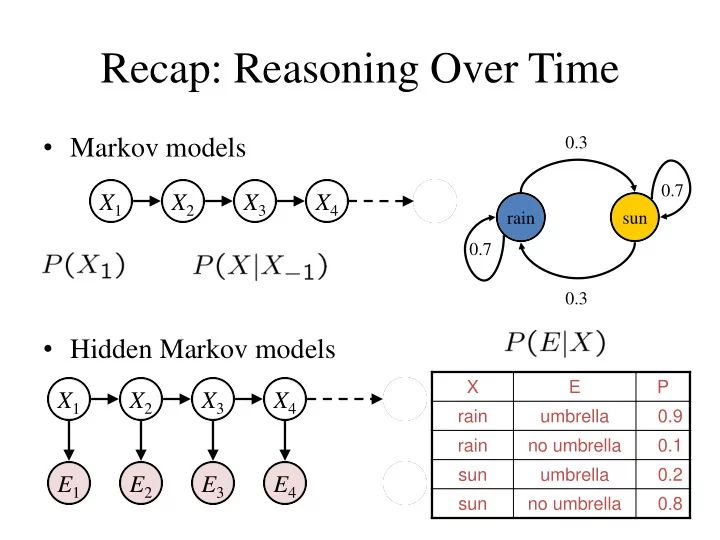

Recap: Reasoning Over Time 0.3 • Markov models 0.7 X 1 X 2 X 3 X 4 rain sun 0.7 0.3 • Hidden Markov models X E P X 1 X 2 X 3 X 4 X 5 rain umbrella 0.9 rain no umbrella 0.1 sun umbrella 0.2 E 1 E 2 E 3 E 4 E 5 sun no umbrella 0.8
Passage of Time • Assume we have current belief P(X | evidence to date) X 1 X 2 • Then, after one time step passes: • Or, compactly: • Basic idea: beliefs get “pushed” through the transitions – With the “B” notation, we have to be careful about what time step t the belief is about, and what evidence it includes
Example: Passage of Time • As time passes, uncertainty “accumulates” T = 1 T = 2 T = 5 Transition model: ghosts usually go clockwise
Example: Observation • As we get observations, beliefs get reweighted, uncertainty “decreases” Before observation After observation
Example HMM
The Forward Algorithm • We are given evidence at each time and want to know We can normalize as we go if we want • We can derive the following updates to have P(x|e) at each time step, or just once at the end…
Online Belief Updates Every time step, we start with current P(X | evidence) • We update for time: • X 1 X 2 We update for evidence: • X 2 E 2 The forward algorithm does both at once (and doesn’t normalize) • Problem: space is |X| and time is |X| 2 per time step •
• Voice Recognition: http://www.youtube.com/watch?v=d9gDcHBmr3I
Filtering • Elapse time: compute P( X t | e 1:t-1 ) Observe: compute P( X t | e 1:t ) Belief: <P(rain), P(sun)> X 1 X 2 <0.5, 0.5> Prior on X 1 <0.82, 0.18> Observe E 1 E 2 <0.63, 0.37> Elapse time <0.88, 0.12> Observe
Particle Filtering • Sometimes |X| is too big to use exact inference 0.0 0.1 0.0 – |X| may be too big to even store B(X) – E.g. X is continuous 0.0 0.0 0.2 – |X| 2 may be too big to do updates 0.0 0.2 0.5 • Solution: approximate inference – Track samples of X, not all values – Samples are called particles – Time per step is linear in the number of samples – But: number needed may be large – In memory: list of particles, not states • This is how robot localization works in practice
Representation: Particles Our representation of P(X) is now a • list of N particles (samples) – Generally, N << |X| – Storing map from X to counts would defeat the point P(x) approximated by number of • particles with value x Particles: (3,3) – So, many x will have P(x) = 0! (2,3) – More particles, more accuracy (3,3) (3,2) (3,3) (3,2) • For now, all particles have a (2,1) weight of 1 (3,3) (3,3) (2,1) 14
Particle Filtering: Elapse Time • Each particle is moved by sampling its next position from the transition model – This is like prior sampling – samples’ frequencies reflect the transition probs – Here, most samples move clockwise, but some move in another direction or stay in place • This captures the passage of time – If we have enough samples, close to the exact values before and after (consistent)
Particle Filtering: Observe • Slightly trickier: – Don’t do rejection sampling (why not?) – We don’t sample the observation, we fix it – This is similar to likelihood weighting, so we downweight our samples based on the evidence – Note that, as before, the probabilities don’t sum to one, since most have been downweighted (in fact they sum to an approximation of P(e))
Particle Filtering: Resample Old Particles: • Rather than tracking (3,3) w=0.1 weighted samples, we (2,1) w=0.9 resample (2,1) w=0.9 (3,1) w=0.4 (3,2) w=0.3 N times, we choose • (2,2) w=0.4 from our weighted (1,1) w=0.4 sample distribution (i.e. (3,1) w=0.4 draw with replacement) (2,1) w=0.9 (3,2) w=0.3 This is analogous to • renormalizing the New Particles: distribution (2,1) w=1 (2,1) w=1 Now the update is (2,1) w=1 • (3,2) w=1 complete for this time (2,2) w=1 step, continue with the (2,1) w=1 next one (1,1) w=1 (3,1) w=1 (2,1) w=1 (1,1) w=1
Robot Localization • In robot localization: – We know the map, but not the robot’s position – Observations may be vectors of range finder readings – State space and readings are typically continuous (works basically like a very fine grid) and so we cannot store B(X) – Particle filtering is often used http://www.youtube.com/watch? v=INLja6Ya3Ig&feature=related http://www.youtube.com/watch?v=kq JpuMNHF_g&feature=related
Ghostbusters Noisy distance prob • Plot: Pacman's grandfather, Grandpac, True distance = 8 learned to hunt ghosts for sport. 15 • He was blinded by his power, but could 13 hear the ghosts’ banging and clanging. 11 9 • Transition Model: All ghosts move randomly, but are sometimes biased 7 5 • Emission Model: Pacman knows a “noisy” distance to each ghost 3 1
Recommend
More recommend